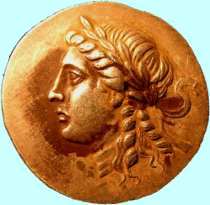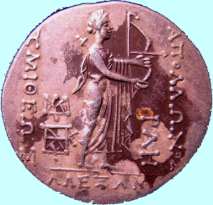|
Roma, 5.5.2008
Egregio
Lettore,
la monetazione
greca non rientra nell'area di mia esperienza e
approfondimento. Tuttavia, allo scopo di soddisfare
almeno in parte la sua richiesta e nei limiti di
quanto dianzi affermato, di seguito le comunico gli
elementi significativi pertinenti alla sua moneta che
mi è stato possibile raccogliere dopo una ricerca nel
web:
Tetradrammo1, Zecca di Alexandria Troas (Troade), 163
a. C.
Descrizione
sommaria (sono indicate in rosso le parti della
leggenda usurate o comunque illeggibili):
D. Apollo,
testa laureata a sinistra.2
R. ALEXAN in esergo. APOLLWNOS ZMIQEWS a destra e a
sinistra a scendere.3
Apollo Sminteo in piedi a destra, faretra sulla
spalla, sorregge arco e freccia con la mano sinistra
e una patera con la destra; a sinistra due
monogrammi, a destra a scendere RLH.4
La ricerca
nel web di monete di tipologia simile ha prodotto i
seguenti risultati:
- http://www.coinarchives.com/a/lotviewer.php?LotID=92716&AucID=99&Lot=388
Classical Numismatic Group > Triton VIII
Auction date: January 11th, 2005 Lot number: 388
Price realized: 2,000 USD Lot description: TROAS,
Alexandria. Circa 188-133 BC. AR Tetradrachm
(16.63 gm, 12h). Estimate $2000 TROAS, Alexandria.
Circa 188-133 BC. AR Tetradrachm (16.63 gm, 12h).
Laureate head of Apollo left / APOLLWNOS ZMIQEWS, ALEXAN in exergue, Apollo Smintheus
standing right, quiver over shoulder, holding bow
and arrow in left hand, patera in right; monogram
to inner left and right. Cf. Bellinger, Troy
A133-A137; BMC Troas -; SNG Copenhagen -; SNG von
Aulock -. VF, toned, minor surface marks, hairline
flan crack. Extremely rare. ($2000) From the Garth
R. Drewry Collection. Ex Triton I (2-3 December
1997), lot 522. Situated on the coast of Asia
Minor, southwest of the site of ancient Troy,
Alexandria Troas was founded by Antigonos I
Monophthalmos around 310 BC, under the name of
Antigoneia. The inhabitants of the new city came
from the neighboring towns of Kebren, Kolone,
Hamaxitos, Neandria, and Skepsis. About a decade
after its founding the place was enlarged by
Lysimachos, king of Thrace, who renamed it
Alexandria in honor of the memory of Alexander the
Great. The city flourished and its prosperity
continued into Roman times. This tetradrachm
belongs to the period of the city’s autonomy
following the devastating defeat of Antiochos III
of Syria by the Romans at the battle of Magnesia
in 189 BC. Apollo Smintheus is depicted on both
sides of the coin, the deity actually being named
in the reverse inscription. While the origin of
his designation is uncertain, though it may be
derived from sminqos, or mouse, whom the Greeks
may have connected with disease; Homer, in the
opening pages of the Iliad, has Apollo Smintheus
bring down plague on the Greeks because of
Agamemnon’s arrogance toward Chryses, the god’s
high priest. Apollo Smintheus’ temple lay at
Chryse, within the territory of Hamaxitos, one of
the cities which had provided the original
population of Alexandria. The statue of the god,
by the celebrated Parian sculptor and architect
Skopas, showed him standing with a mouse at his
feet.
- http://www.coinarchives.com/a/lotviewer.php?LotID=98582&AucID=105&Lot=198
Numismatica Ars Classica > Auction 29 Auction
date: May 11th, 2005 Lot number: 198 Price
realized: 3,250 CHF (approx. 2,697 U.S. Dollars as
of the auction date) Lot description: Greek Coins
Troas, Alexandria No.: 198 Schätzwert/Estimation:
CHF 3000.- d=34 mm Tetradrachm circa 171, AR
16.94g. Laureate head of Apollo l. Rev. APOLLONOS
- SMIQEWS Apollo Smintheus standing r., chlamys
over l. shoulder, holding patera in r. hand and
armed bow in l.; in inner l. field, two monograms.
On exergual line on r., RL (130). In exergue,
ALEXAN. An apparently unique and unpublished year
of a very rare type. Good very fine Alexandria
Troas was founded with the name Antigioneia, by
Antigonos I Monophthalmos at around 310 BC. It was
situated on the coast of Asia Minor, southwest of
the ancient city of Troy. Its inhabitants came
from the nearby cities of Kebren, Kolone,
Neandria, Hamaxitos and Skepsis. The city was
expanded by Lysimachos, King of Thrace, almost a
decade after it was founded. He also renamed the
city Alexandria in honour of Alexander the Great.
The city remained prosperous well into Roman
Times. This tetradrachm was most probably issued
during the cities period of autonomy following
Antiochos III of Syria defeat by the Romans at the
battle of Magnesia in 189 BC. Apollo Smintheus is
represented on both sides of this tetradrachm and
also being named on the reverse. His designation
may have originated from sminqoV (mouse), with
which the Greek may associated disease. In the
Iliad, Homer has Apollo Smintheus bring the plague
to the Greeks as a punishment for Agamemnos’s
arrogance toward Chryse, the god’s high priest.
Apollo’s temple was built at Chryse in the
territory of Hamaxitos, one of the cities from
which the original population of Alexandria came
from. The statue of Apollo, sculpted by the great
Parian, shows Apollo standing with a mouse at his
feet. The dating of the coins of Alexandria Troas
does not present any problem of arrangement, as
the date from the foundation of the city (300 BC)
is shown on the reverse of the coins. The first
known issue up to date was 164 BC (137 year after
the foundation). The coin here offered, a
previously unrecorded issue, records a date of 130
years after the city foundation, therefore seven
years prior to the first known issue.
- http://www.s110120695.websitehome.co.uk/SNG/sng_reply2a.php?verb=SNGuk_0300_2731
SNG Vol: III 2731 Lockett Collection State:
Alexandreia Troas OBV Description: Apollo l.,
laur. REV Description: Apollo Smintheus standing
r., bow and qiver at shoulder. REV Inscription:
ALEJANDREVN - ARISTOU REV Secondary Inscription:
[AP]OLLVNOS [Z]MIYEVS Period: First quarter 1st
cent. -100 -75 Die Axis in numbers: 12 Die Axis in
degrees: 0 Metal: AR Denomination: Tetradrachm
Weight: 16.3 Wear: Worn Cast or Struck: Struck
Acquisition: Manner of Acquisition: Purchase
Auction House: Naville Sale Number: 1 Date of
First Day: 04/04/1921 Lot Number: 2267 ID:
SNGuk_0300_2731.
- http://www.fitzmuseum.cam.ac.uk/dept/coins/opac/cataloguedetail.html?&priref=113042&_function_=xslt&_limit_=10
Maker/s Alexandria (mint) Collection Lewis
Collection Category coin Name Greek (Series) Troas
(subseries) Alexandria (subsubseries) tetradrachm
(denomination) Material/s silver Dimensions
image(height): 32 mm image(width): 33 mm weight:
16.77 g die axis: 0 degrees Date circa 95 to 85
Provenance loan: Lewis, S.S. 1991 (Filtered for:
Coins and Medals) Inscriptions/Marks design
Position: obverse Description: Laureate head of
Apollo design Position: reverse Description:
Apollo Smintheus holding patera, bow and arrow;
legend Catalogue ref/s 862 LW-0861 Accession
Number CM.LS.862-R (Coins and Medals) (Reference
Number: 113042; Input Date: 2004-11-23 / Last
Edit: 2004-11-23).
Venendo
alle conclusioni, nonostante le caratteristiche
fisiche (peso/diametro/asse di conio) siano
comparabili con quelle dei conî d'epoca, desta
perplessità l'aspetto complessivo della moneta. Anche
ammettendo che il colore rosato discenda dalla cattiva
luce, non trovano giustificazione le macchie vistose
presenti sulla superficie del rovescio, difficilmente
compatibili con un tondello che in linea teorica
dovrebbe essere d'argento puro. Penso dunque che la
moneta sia una copia moderna.
Un saluto
cordiale.
Giulio De
Florio
----------
(1) Raccolgo in tabella le caratteristiche
fisiche dei tetradrammi della tipologia di figura
tratti dai link di cui sopra:
| Riferimenti |
Peso (g.) |
Diametro (mm) |
Asse di
conio (h) |
| Link1 |
16,63 |
- |
12 |
| Link2 |
16,94 |
34 |
- |
| Link3 |
16,30 |
- |
12 |
| Link4 |
16,77 |
32-33 |
12 |
Dalla tabella
si evince che le caratteristiche fisiche della moneta
comunicate dal lettore (16,60g, 31mm, 12h) sono
compatibili con quelle dei conî d'epoca.
(2) Apollo è il nume protettore della città
di Alessandria nella Troade (v. geografia),
città
posta c. 10 miglia a sud dell'antica Troia (v. riferimento).
(3) La leggenda del rovescio include
verosimilmente in sequenza sia il nome in esergo, ALEXAN, che la parte riportata in verticale, APOLLWNOS ZMIQEWS. Se così è, l'etnico nella sua
estensione potrebbe recitare così: "... nel nome degli
Alessandrini (cioè degli abitanti di Alessandria)
posti sotto la protezione di Apollo Sminteo", ove
Sminteo è l'epiteto di Apollo "sterminatore di topi
campestri" che, applicato al dio, era originariamente
riferito ad una divinità pre-ellenica.
(4) RLH dovrebbe indicare la data in cui
la moneta fu battuta (163 a. C., cioè 138 anni dopo la
fondazione della città, avvenuta nel 300 a. C. -
vedere in proposito, per la conversione tra lettere
greche e numeri, il sito http://parthia.com/parthia_calendar.htm#Year
e, per un esempio di conversione, il sito http://www.asiaminorcoins.com/gallery/displayimage.php?album=72&pos=0). |

